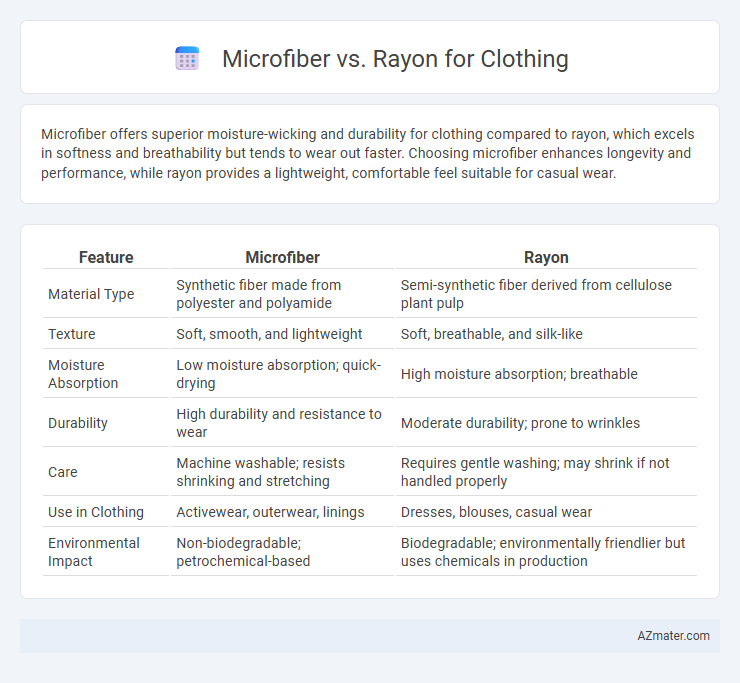Microfiber offers superior moisture-wicking and durability for clothing compared to rayon, which excels in softness and breathability but tends to wear out faster. Choosing microfiber enhances longevity and performance, while rayon provides a lightweight, comfortable feel suitable for casual wear.
Table of Comparison
| Feature | Microfiber | Rayon |
|---|---|---|
| Material Type | Synthetic fiber made from polyester and polyamide | Semi-synthetic fiber derived from cellulose plant pulp |
| Texture | Soft, smooth, and lightweight | Soft, breathable, and silk-like |
| Moisture Absorption | Low moisture absorption; quick-drying | High moisture absorption; breathable |
| Durability | High durability and resistance to wear | Moderate durability; prone to wrinkles |
| Care | Machine washable; resists shrinking and stretching | Requires gentle washing; may shrink if not handled properly |
| Use in Clothing | Activewear, outerwear, linings | Dresses, blouses, casual wear |
| Environmental Impact | Non-biodegradable; petrochemical-based | Biodegradable; environmentally friendlier but uses chemicals in production |
Introduction to Microfiber and Rayon
Microfiber, composed of ultra-fine synthetic fibers such as polyester or nylon, offers exceptional softness, durability, and moisture-wicking properties, making it popular for activewear and casual clothing. Rayon, a semi-synthetic fiber derived from regenerated cellulose, mimics the feel and drape of natural fibers like cotton or silk, providing breathability and a smooth texture ideal for lightweight garments. Understanding the fiber composition and fabric performance of microfiber versus rayon helps consumers select clothing based on comfort, care, and specific wear needs.
Understanding Microfiber Fabric
Microfiber fabric, made from ultra-fine synthetic fibers such as polyester and nylon, offers superior moisture-wicking and durability compared to rayon, which is derived from natural cellulose fibers. Its tightly woven structure enhances breathability and softness, making microfiber ideal for activewear and performance clothing. The fabric's resistance to wrinkles and shrinkage further ensures longevity and ease of care in everyday apparel.
What is Rayon?
Rayon is a semi-synthetic fiber made from cellulose derived primarily from wood pulp, offering a soft and breathable texture that mimics natural fibers like cotton or silk. It is highly absorbent and breathable, making it suitable for warm weather clothing, while its smooth finish enhances comfort and drape. Despite being less durable than synthetic fibers like microfiber, rayon provides excellent dye affinity, resulting in vibrant and long-lasting colors in garments.
Key Differences Between Microfiber and Rayon
Microfiber, composed of ultra-fine synthetic fibers like polyester or nylon, offers superior moisture-wicking, durability, and wrinkle resistance, making it ideal for activewear and performance clothing. Rayon, a semi-synthetic fiber derived from cellulose, provides a softer, more breathable texture with excellent drape, commonly found in casual and summer wear. Key differences include fiber origin (synthetic vs. semi-synthetic), moisture management properties, and fabric care requirements, where microfiber tends to dry faster and resist shrinking compared to rayon.
Comfort and Feel: Microfiber vs Rayon
Microfiber fabric offers a smooth, soft texture with superior moisture-wicking properties, making it comfortable for activewear and everyday clothing. Rayon provides a breathable, lightweight feel that mimics natural fibers, delivering a cool and silky touch ideal for warm weather garments. Both materials excel in comfort, but microfiber tends to retain softness and shape longer, while rayon drapes elegantly with a more natural feel.
Durability and Longevity Comparison
Microfiber fabric, made from synthetic fibers such as polyester or nylon, offers superior durability and resistance to wear and tear compared to rayon, which is derived from natural cellulose fibers. Microfiber's tightly woven structure enhances its longevity by resisting pilling, stretching, and color fading, making it ideal for frequent use and washing. Rayon, while soft and breathable, tends to weaken over time, especially when exposed to moisture and friction, resulting in reduced lifespan compared to microfiber garments.
Breathability and Moisture Management
Microfiber fabrics, made from ultra-fine synthetic fibers, excel in moisture-wicking and breathability by allowing sweat to evaporate quickly, making them ideal for activewear. Rayon, a semi-synthetic fiber derived from cellulose, offers moderate breathability but tends to retain moisture longer, which can reduce comfort during intense physical activity. When prioritizing breathability and moisture management in clothing, microfiber outperforms rayon by efficiently keeping the skin dry and cool.
Environmental Impact: Sustainability Concerns
Microfiber, primarily made from synthetic polymers like polyester and nylon, contributes significantly to microplastic pollution as its fibers shed during washing, posing environmental hazards in aquatic ecosystems. Rayon, derived from cellulose in wood pulp, involves intensive chemical processing and deforestation, raising concerns about habitat destruction and water pollution. Both materials present sustainability challenges, with microfiber's non-biodegradability and rayon's resource-intensive production emphasizing the need for environmentally responsible alternatives in clothing manufacturing.
Common Uses in Fashion and Apparel
Microfiber and rayon serve distinct roles in fashion; microfiber excels in activewear, sportswear, and outerwear due to its moisture-wicking and durable properties. Rayon is favored for casual and formal clothing like dresses, blouses, and linings because of its soft texture and breathability. Both fibers contribute to versatile wardrobes, addressing different needs from performance to comfort.
Choosing the Right Fabric: Microfiber or Rayon?
Microfiber offers exceptional durability and moisture-wicking properties, making it ideal for activewear and outdoor clothing, while rayon provides a soft, breathable texture suited for comfortable everyday garments. Choosing between microfiber and rayon depends on the intended use: microfiber excels in wrinkle resistance and quick drying, whereas rayon delivers a silky feel and better breathability. Consider fabric performance factors such as moisture management, comfort, and maintenance requirements to select the right material for your clothing needs.

Infographic: Microfiber vs Rayon for Clothing
 azmater.com
azmater.com